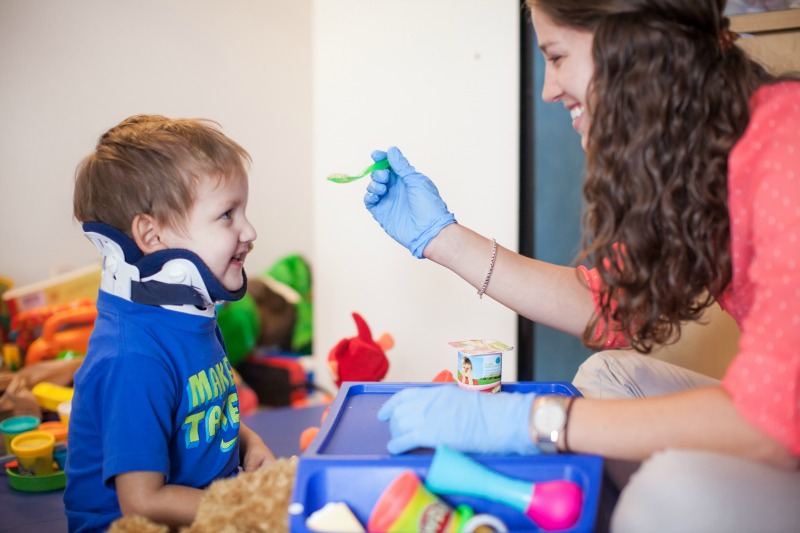Feeding Therapy Farmingdale NY: Supporting Healthy And Balanced Consuming
Wiki Article
Navigating the Course to Effective Feeding: Innovative Approaches and Interventions for Effective Feeding Treatment
Are you struggling to discover efficient approaches and interventions for successful feeding therapy? Plus, we'll show you the importance of working together with family members and caregivers for optimal feeding outcomes. Get prepared to browse the path to successful feeding!Assessing Feeding Challenges and Identifying Goals
You ought to start by examining your child's feeding difficulties and determining certain objectives for their therapy. This action is essential in establishing an efficient feeding treatment plan. Begin by observing your child's feeding patterns and behaviors. Look for any hostilities or troubles they may have towards particular foods or appearances. Bear in mind of any kind of physical or sensory concerns that might be affecting their capability to eat. You can after that establish particular goals for their therapy when you have recognized these obstacles. These objectives should be reasonable and attainable, concentrating on enhancing your child's feeding abilities and total nourishment. For instance, you may establish a goal for your kid to be able to tolerate a wider selection of structures or to self-feed with tools. It is essential to interact these objectives with your kid's feeding specialist so they can customize the treatment sessions to deal with these certain difficulties. By examining your youngster's feeding obstacles and setting goals, you are taking the first step in the direction of helping them develop effective feeding skills.Implementing Evidence-Based Techniques for Feeding Treatment
Implementing evidence-based approaches for feeding treatment can cause positive outcomes for kids. When you incorporate these methods right into your youngster's treatment strategy, you are ensuring that the interventions used are supported by scientific study and have been shown effective. This approach enhances the chance of success and aids attend to the particular feeding difficulties your kid might be experiencing.By following evidence-based strategies, you can give your child with the very best feasible care and support. These approaches may consist of utilizing a variety of sensory experiences throughout mealtimes, such as exploring different structures and flavors, to encourage approval of new foods. Furthermore, executing actions modification techniques can aid attend to particular eating practices and advertise much healthier eating patterns.
An additional important aspect of evidence-based feeding treatment is including the family in the therapy procedure. By offering education and learning and support to parents and caretakers, they can play an active duty in assisting their child overcome feeding challenges. This joint method enhances the efficiency of therapy and advertises enduring positive modifications in your youngster's eating habits.

Resolving Sensory Processing Issues in Feeding Therapy
Dealing with sensory processing issues in feeding treatment can be tough, yet it is important for promoting a positive consuming experience for kids. When you come across a kid with sensory processing troubles throughout nourishment, it is vital to recognize that their responses to certain textures, preferences, scents, and even noises are not willful (feeding therapy farmingdale ny). By acknowledging and addressing these concerns, you can help develop a supportive environment that encourages healthy eating practices
This technique allows the kid to become acquainted with the food and its sensory properties at their very own rate. Furthermore, offering a selection of appearances and flavors can assist desensitize their sensory system and expand their food choices.
Engaging the kid in sensory play tasks can also be advantageous. Urge them to explore different appearances, such as squishing, squeezing, or touching numerous food items. This can assist stabilize sensory input and reduce aversions to certain textures.
One more vital aspect is offering a structured and tranquil eating environment. Minimize disturbances, such as bright lights or loud sounds, which can overwhelm their detects and prevent their capacity to concentrate on consuming. Creating a foreseeable routine and using visual timetables can additionally aid the child really feel even more safe and in control throughout nourishment.

Making Use Of Assistive Innovation and Adaptive Tools
Using assistive modern technology and flexible tools can considerably enhance the feeding experience for children with sensory handling difficulties. Mealtime can be tough and frustrating when you have problem with sensory processing. With the right devices, you can make it a more delightful and successful experience.One option is making use of specialized utensils and plates made to suit your needs. These utensils might have textured manages or a larger hold, making them simpler to hold and adjust. Plates with divided areas can aid separate various foods and avoid them from touching, which can be a resource of discomfort for some kids.
Along with specialized utensils and plates, there are additionally assistive gadgets that can be utilized during feeding. description A heavy vest or lap pad discover this info here can provide deep pressure input, aiding to soothe and manage your sensory system. A shaking toothbrush or chewable precious jewelry can provide oral sensory excitement, making the act of eating more satisfying.
Modern technology can likewise contribute in enhancing the feeding experience. There are applications and devices offered that can give visual or auditory hints, such as timers or triggers, to help you stay focused and arranged throughout nourishment.
Teaming Up With Households and Caregivers for Successful Feeding Outcomes
When working together with family members and caretakers, you can work together to create a helpful and caring environment for effective feeding results. By including households and caregivers in the feeding treatment procedure, you can obtain beneficial understandings right into the youngster's feeding behaviors, obstacles, and choices. food aversion therapy long island. This collaboration allows for an all natural strategy to feeding therapy, dealing with not only the physical facets however also the emotional and psychological factors that might affect a child's feeding capacitiesOne key facet of teaming up with caregivers and families is giving education and learning and training. By furnishing them with knowledge and abilities, they can actively join the feeding treatment process and sustain the kid's progress beyond therapy sessions. This can consist of showing them feeding techniques, methods for managing mealtime behaviors, and recognizing the significance of uniformity and regimen in establishing healthy and balanced eating routines.
In addition, entailing households and caretakers in setting goal and treatment planning makes sure that their perspectives and goals for the youngster are taken into factor to consider. By working with each other, you can develop achievable and practical goals that line up with the family members's priorities and values - food therapist long island. This joint approach cultivates a sense of possession and empowerment, developing a strong foundation for successful feeding end results
Additionally, open and routine interaction with caregivers and family members is important for efficient partnership. By maintaining continuous discussion, you can attend to problems, provide support, and make needed changes to the feeding treatment strategy as required. This interaction also enables sharing progress updates, celebrating achievements, and identifying any type of challenges or barriers that might occur.

Final Thought
You have discovered various methods and interventions for efficient feeding treatment, such as assessing difficulties, implementing evidence-based methods, addressing sensory processing problems, and making use of assistive modern technology. Keep in mind to constantly remain proactive and innovative in your technique to feeding treatment.It's vital to communicate these goals with your kid's feeding specialist so they can tailor the therapy sessions to deal with these certain obstacles.Implementing evidence-based methods for feeding treatment can lead to favorable end results for youngsters.Attending to sensory handling issues in feeding therapy can be tough, yet find more it is crucial for promoting a positive eating experience for children. By involving families and caretakers in the feeding therapy process, you can get valuable insights into the kid's feeding difficulties, preferences, and habits. By outfitting them with expertise and abilities, they can actively take part in the feeding treatment process and support the youngster's progression outside of treatment sessions.
Report this wiki page